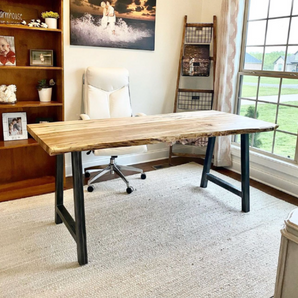An In-depth Look at Table Leg Styles: Finding the Perfect Match
Choosing the best dining table leg design is critical for both aesthetic charm and useful functionality. Traditional four legs supply timeless sophistication and security, while the pedestal base supplies raised legroom and a modern-day look. For those with bigger tables, trestle legs make sure durable support, whereas hairpin legs introduce a mid-century modern-day vibe with their minimal style. The x-shaped legs mix contemporary design with enhanced security. Each of these options brings one-of-a-kind benefits, making the option greater than just an issue of preference. Check out further to uncover which style perfectly matches your dining area and way of living.
Standard Four Legs
Among the different types of dining table leg styles, the conventional four-leg style stays an ageless option for numerous households. Four legs supply well balanced assistance, making sure the table stays steady and capable of birthing substantial weight (dining room table legs).
From an aesthetic perspective, the typical four-leg layout can be quickly adapted to various indoor styles. Whether crafted from timber, metal, or a combination of products, these legs can be delicately carved, smooth and minimalistic, or anything in between. Their adaptability enables them to complement both rustic and modern setups perfectly.
Additionally, the simple structure of the four-leg layout promotes simplicity of movement and positioning within a room. Unlike even more complex bases, this design reduces obstructions, giving adequate legroom for diners. In recap, the conventional four-leg table leg style marries sustaining beauty with practical performance, making it an astute selection for those seeking both kind and function in their dining furniture.
Pedestal Base
Frequently commemorated for its stylish and space-efficient layout, the pedestal base is a notable option to the typical four-leg setup in eating table leg designs. This unique base generally features a single main column sustaining the tabletop, which can differ in kind, from ornately carved timber to sleek, contemporary steel. One of the main advantages of the pedestal base is its capacity to maximize legroom and seating versatility. Without edge legs, diners are afforded better freedom of motion, making it an excellent choice for round and oval tables that advertise even more intimate and inclusive events.
The main column itself uses a canvas for elaborate designs and imaginative expressions, adding an element of aesthetic rate of interest beneath the table. In recap, the pedestal base combines functionality with style, making it an improved and useful alternative for varied dining settings.
Trestle Legs
Trestle legs provide a robust and classic foundation for eating tables, defined by their horizontal cross-bracing and strong assistance beams. Stemming from middle ages times, this layout has advanced yet kept its important structure, making it a seasonal fave in both standard and modern settings. The main trestle beam, usually sustained by two or more upright articles, uses outstanding security, enabling larger table sizes without the need for extra legs.
A significant advantage of trestle leg tables is the enough legroom they provide. Unlike tables with 4 corner legs, the lack of blockages at the table's edges supplies unblocked space for chairs and diners, improving convenience and ease of access. This makes trestle tables ideal for fitting bigger celebrations, whether in a dining-room or a banquet hall.
The visual convenience of trestle legs is noteworthy. Offered in a range of products such as wood, steel, and composite, they can be ended up to enhance a variety of indoor designs. From rustic farmhouse to streamlined modern-day styles, trestle legs can be customized to fit specific preferences. Their enduring appeal and practical advantages make trestle legs an engaging selection for those looking for both design and practicality in their table.
Barrette Legs

The allure of hairpin legs hinges on their simpleness and versatility - dining room table legs. Offered in a series of materials, including steel and brass, they can be completed in numerous news colors to match various indoor styles. Whether coupled with a rustic wood table top or a modern glass surface, hairpin legs easily mix functionality with a touch of classic beauty
Sturdiness is an additional notable function of hairpin legs. In spite of their fragile appearance, these legs are engineered to bear significant weight, ensuring the table remains stable and safe. Furthermore, they are fairly very easy to install, making them a popular selection for DIY enthusiasts and professional furniture makers alike.
X-Shaped Legs

Built from products such as steel, wood, or a mix of both, X-shaped legs can be customized to match different design preferences. Steel legs often read review provide a streamlined and industrial feel, suitable for loft-style houses and modern dining rooms. On the various other hand, wooden X-shaped legs use a warmer, extra rustic appeal, appropriate for farmhouse or eclectic insides. The versatility in materials permits homeowners to customize their dining tables to much better fit their general style system.
Moreover, the engineering behind X-shaped legs guarantees even weight distribution, lessening the threat of wobbling and improving longevity. This makes them specifically fit for bigger eating tables that call for added assistance. Fundamentally, X-shaped legs blend functional additional resources engineering with contemporary looks, making them a classic selection for varied dining atmospheres.
Final Thought
A detailed understanding of eating table leg designs reveals the distinctive attributes and benefits of each layout. Trestle legs make sure robust assistance for bigger tables, and barrette legs introduce a mid-century modern-day aesthetic.